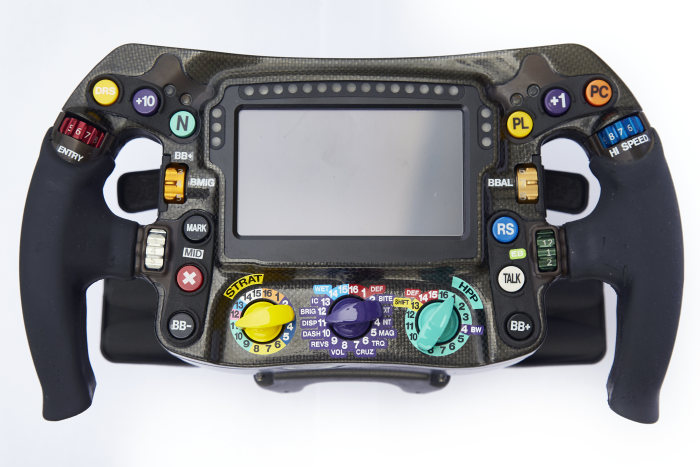What all the controls do on a modern-day F1 steering wheel
For F1 drivers at 320Km/h, steering wheel is the only way for controlling the next moment in the race
 Controls decoded
Controls decodedAn F1 car’s steering wheel is an immensely complicated device. It’s got a ton of buttons and knobs going on, so much more than the regular steering mounted controls on your daily driver. That’s because in addition to just driving the car, there’s a lot more the driver needs to manage when doing 300kmph down the back straight of a circuit. In this story, we decode what the different buttons do and how they help the driver.
STRAT Mode (Lower left knob): This is for altering engine modes. It comes in handy when you want that extra push while overtaking, or even when you want to conserve the engine power.
Menu Mode: This allows the driver to change multiple parameters like the volume of the radio or the brightness of the display right from one place; the driver can add all the menu options which they think are needed the most, thus making it convenient.
Race Start: This allows the driver to engage maximum power at the start line and allows them to have a heathy start. Think of it like launch control on a road car.
Shift paddles: The shift paddles are similar to the ones that we use in our roads cars. In fact, it was an innovation that was pioneered in Formula 1 and then made its way to road cars. The driver upshifts with the right paddle and downshifts with the left paddle.
Pit Confirm: This allows the driver to send a heads-up prior to coming for the pit stop, allowing the crew members to be ready for the pitstop. The radio exists too, but this allows you to bypass that route.
LED strip: The LEDs on this strip light up progressively as the revs of the car rise. These LEDs are a visual indicator to the driver of when he should be shifting gears to extract the most from the engine. Generally, when ready for the shift, they change colour so the driver can see them in his peripheral vision and react.
DRS button: The DRS, or drag reduction system, was an innovation brought in to Formula 1 last decade to improve the overtaking in a race. The button allows the rear wing to move parallel to the ground, this reducing drag and improving acceleration and top speed. The rules state that this can only be used when I driver is one second behind another one.
Engine Braking: This controls the engine braking and plays a crucial role in how much the car decelerates when off the throttle. Drivers have to manage their braking inputs to deal with different engine braking levels.
Pit Lane (PL orange button on the right top corner): This is for maintaining the pit lane speed. This button limits the car to 80kmph and prevents them from accidentally overspeeding and picking up a penalty.
Talk: This allows the driver to communicate with the engineers in the pits. This is essential for planning strategy, pit stops, communicating the health of the car and any other important bits of information through the race. For Kimi Raikkonen, it is vital as he needs to know if he can have a drink.
Entry, Mid+ Hi-Speed Rotaries: This is used to adjust the differential at different phases of the corner. The diff needs to have different characteristics at different points in the corner to put down torque effectively and this set up can be changed from these rotary dials.
Gearbox Neutral: This is used only after a race and is for placing the car in neutral gear. If you hold the neutral button for long enough, the gear shifts to reverse.
Drinks: This allows the F1 drivers to replenish themselves with fluids as during a race due to the heat from the engine and the electronics. Racing is dehydrating and the driver may lose two-three litres of fluid per race.
The steering wheel has always been an enigmatic device and pre-season testing this year saw another innovation from Mercedes-Benz. The DAS, or Dual Axis Steering, allowed drivers to control the toe angle of the car to improve straight line speed and cornering grip, as the situation requires. This was done by moving the steering column forward and backwards, in addition to rotating to to change direction!


